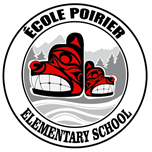A Bit of Poirier History…
Joseph Poirier was born in 1829 in Quebec. After many adventures his life came to its close at his home a continent away in Sooke in 1898. A century-after his death, it is fitting that the legacy of his family is remembered by the naming of a school built on land near to Poirier’s own pre-emption.
As a youth, French-speaking Joseph Poirier set off with others from his Quebec village to join the fur traders heading west. Traveling the Canadian route, the voyageurs reached the settlement at Red River in what is now Manitoba. From there, they took a more southerly course and reached the Hudson’s Bay Company’s western headquarters. Fort Vancouver, on the Columbia River.
A French Canadian community had developed of Hudson’s Bay Company émigrés and their native wives, south of the fur-trading fort, in the-nearby wide fertile valley of the Willamette River. When the Oregon Treaty of 1846 declared this area as a part of the American Republic, many of the émigrés of Quebec origin decided to move north into territory which still remained as British domain. The Hudson’s Bay Company posts at Fort Langley and Fort Victoria were natural destinations.
Joseph Poirier joined a wagon train traveling north. Among those in his group were Jean Baptiste Brule, also from Quebec, who had married Marguerite (originally from the T’Sou-ke First Nations people) in Fort Vancouver. Marguerite Brule had a son Joseph Iroquois, from a previous marriage, and this son together with his wife Mary Ann, of the Kalapooya nation in the Willamette Valley, journeyed northward in the family group.
Jean Bapriste Brule and his family settled on the east bank of the Sooke River. Joseph Poirier first learned of work in the area falling timber for the-sawmill of Sooke’s first independent immigrant settler, Scottish Captain W. C. Grant. Poirier soon followed.
Brule’s lead, taking up the land now known as Milne’s Landing. During the Leechtown gold rush-of l864, Poirier and Brule rafted in sheep and cattle to their riverside base to provide mutton and beef for sale to the miners enroute to the goldfields.
Poirier married Ellen, one of the young daughters of Mary Ann and Joseph Brule. Building a cabin on the river flats, the couple began raising their family, ultimately to include the births of fifteen children. By the mid-1880’s, Joseph Poirier sold this riverside land to Edward Milne Sr, and moved his family to property on what is now known as Grant Road, near its junction with Otter Point Road.
The firstborn of Joseph and Ellen Poirier’s children was also given the name Joseph. When-he grew up, Joseph Jr worked in the sealing industry, then took up a section of land at today’s West Coast Road and Kemp Lake Road, where he established a reputation as a farmer and as a steam engineer. He married Mary White, daughter of Aaron Denton White and Catherine “Owechemis” White, of West Coast native origin. Joseph Poirier Jr. and his wife Mary had four daughters and three sons. Besides Poirier, their descendants’ names readily recognized in the area today include the George Goudie family, the Walter and Claude Cook families and the Jessimans.
Joseph and Ellen’s second son Adolphus Poirier, went sealing with his brother, and the two were part of a consortium which purchased the first sleek east-coast built vessel “Agnes MacDonald” for use in the sealing industry. A story was told, only half in jest, that Joseph Poirier Jr., a gregarious man with many attractive sisters, brought home shipmates each year from the sailing ships to visit his family, until all his sisters were married.
Best known of the families in Sooke perhaps from this seal-hunting history, were Isobel Poirier’s marriage to Andrew Davidson, and Ellen Poirier’s marriage to Thomas Robinson. Son James Poirier married A1ice White, daughter of Aaron Denton White and Catherine; well known among their descendants today is the-Richard Poirier family of Jordan River.
Harry Dilley married into the Poirier family, and Dilley family descendants are also well-known in Sooke. Lidgates, O’Mearas and McMillans, too, are among the many Poirier family names. The Poirier daughter who left the largest number-of descendants however, was Sarah who married seaman Mandus Michelson and produced five sons; Mandus, Earland, Paul, Eric and Rolf. The couple’s daughters has also left their mark – the eldest, Sarah married William Vowles; Lily married Jimmy Goudie and then Alf Haywood; Agnes married John Bush, then Claude Dilley; Christine married Jack Blight; and Marie married Art Hay.
The extended Poirier family eventually came to represent what was probably the-largest workforce in the district. Lily Haywood, now well into her eighties, reminisces today of Ellen Poirier “I still remember Grandma Poirier. She was a little lady wearing black, very strict, who always spoke French.”
Bringing this family forward another generation includes great-grandchildren to number in the hundreds. Among the best recognized in Sooke, perhaps, have been the fourteen children of Sarah Michelsen and William Vowles.
In early generations, the Poiriers gained an enormous local reputation for their skills as woodsmen, fishermen, hunters and farmers. Today they continue-to carry on these roles in addition to others – in the fields of business, arts and culture and community leadership. One example of contribution to community development would be that of a grandson of Joseph-Poirier, Eric Michelsen, Besides his occupation of lumbering, Eric Michelsen developed Broome Hill Golf Course into a successful-enterprise, and was serving as elected president of Sooke Community Association when he passed away in 1973.
The impact and legacy of the Poirier family is immense – in citizenry of the area, in their many years of work in the varied industries of the district, and in their contributions to the development of the region.
Thanks to Elida Peers, Historian, Sooke Region Historical Society
